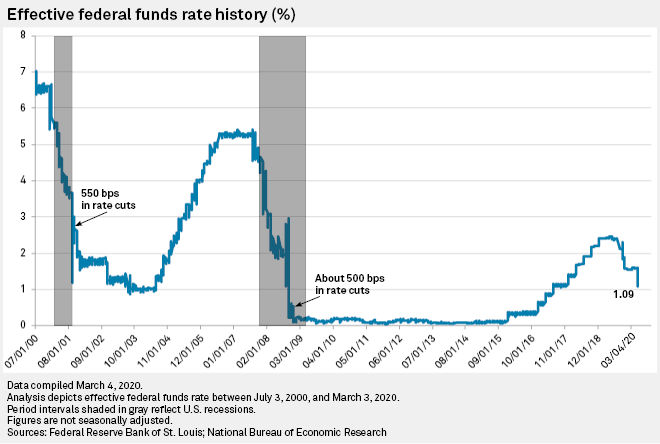The Federal Reserve's willingness to lower interest rates ahead of a deterioration in economic data means it is unlikely to be done easing policy, analysts say.
The Fed's emergency rate cut on March 3 came despite little concrete evidence that the coronavirus has dampened U.S. economic growth, though there are plenty of signs that it could do so soon.
But the Fed "wants to be more proactive than reactive" in addressing evolving economic risks, according to Ellen Zentner, chief U.S. economist at Morgan Stanley, who sees the Fed easing policy again as early as its March 17-18 meeting.
"They are pre-empting potentially significant financial market disruptions that could amplify [the] downside effects" that the coronavirus could have on U.S. growth, Zentner wrote in a research note.
The coronavirus, which has disrupted global supply chains and weighed heavily on the tourism industry, is widely expected to damage the world economy this year, with the International Monetary Fund projecting a deceleration in global GDP growth from 2019 levels.
Those worries have shaken U.S. stock markets, which saw their worst week since the 2008 financial crisis last week and slipped again March 5 after ending in the green twice this week. The S&P 500 index ended the day down 3.39% to 3,023.94.
But the coronavirus has had limited impact on backward-looking U.S. economic data and its effects may not show up for some time. Indeed, investors are expected to largely ignore the February jobs report due out on March 6, which will likely show steady U.S. jobs gains but "will be viewed as old news," wrote Stephen Stanley, chief economist at Amherst Pierpont Securities.
"Rarely has an employment report been less important to the financial markets than this one," he wrote in a note to clients.
Fed Chairman Jerome Powell told reporters March 3 that the economic effects of the coronavirus are at a "very early stage," noting supply chain disturbances and tourism industry worries as two sources of concern while also flagging dips in sentiment indicators.
"We expect that will continue. It will probably grow," Powell said. "And that's one of the reasons we have come to the view that it would be appropriate for us today to move to support the economy."

The Fed decision had some detractors, most notably former Treasury Secretary Lawrence Summers, who told Bloomberg TV the Fed should have held off on easing, given that it has few short-term rate cuts at its disposal compared to past decades.
"When you've only got limited ammunition, you've got to conserve it," Summers told Bloomberg TV, adding that lower rates cannot mend supply chains nor stop the spread of the virus.
But although Fed easing has its limits, it is not "completely ineffective," wrote Beth Ann Bovino, U.S. chief economist at S&P Global Ratings. Fed rate cuts can help calm markets and provide a cushion to companies that will come under pressure from the coronavirus, she wrote, and they can "speed up recovery in the second half of the year" given that monetary policy changes take some time to take effect.
Fed officials are well aware that they have edged closer to what economists call the "zero lower bound," when central banks have already slashed rates to near-zero levels and need to turn to unconventional strategies like the large-scale asset purchases the Fed conducted after the financial crisis.
But the consensus at the Fed appears to take the opposite view of Summers' prescription of patience.
New York Fed President John Williams, whose career has focused on researching the issue, said in July 2019 that academic research has shown central banks should not keep their "powder dry" and take a wait-and-see approach when they are close to the zero lower bound.
"In that case, you want to do the opposite and vaccinate against further ills," Williams said at the time. "When you only have so much stimulus at your disposal, it pays to act quickly to lower rates at the first sign of economic distress."
A related academic concept also argues for the Fed to take a more aggressive approach in responding to the coronavirus risks, according to Scott Sumner, an economist at the Mercatus Center at George Mason University.
When Fed officials look to provide monetary stimulus, they tend to do so by setting rates below a so-called neutral rate, a hypothetical figure that neither stimulates nor slows the economy. The current growth concerns appear to be leading to a sharp drop in that equilibrium rate, Sumner said, pointing to growing pessimism in bond markets as one sign that investors see slower growth going forward. The latest such indicator came on March 5, when the yield on the benchmark 10-year U.S. Treasury slipped below 0.90% for the first time ever as demand for the perceived safety of U.S. bonds rose.
The Fed should heed those worrying indicators as a signal that "monetary policy is too tight," Sumner said.
"If the Fed doesn't cut rates when the equilibrium rate falls, then monetary policy would effectively get tighter, and that's not desirable right now," Sumner said.



